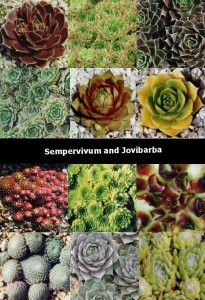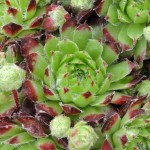
Plants will vary in price and container size Some will only be available during dormancy – late Fall or early Spring — and will be updated this winter. Seed or plant exchanges are always welcome!
Due to PayPal’s inability to handle and charge appropriate fees for multiple combinations I decided to re-edit all my listings to a ‘plant cost only.’ At the bottom of each listing page will be three shipping alternatives.
Go directly to Plants: A B C D E F G H I J K L M N O P Q R S T U V W Y Z
Sedums and hardy Succulents — hardy ground cover forms that can are hardy to at least z8. Jovibarba and heuffelii Succulents that can take severe winter cold. These ground cover Succulents: Low growing or trailing succulents of various color, form, and texture. Given proper drainage most are easy to grow, spread rapidly, and give great diversity to areas of special interest. Try them in a combination to make great container plants or a smashing rock garden display.
Ground Cover Sempervivum Collection: 6 ground cover plants</strong>. Low growing or trailing succulents of various color, form, and texture. Six different plants, (Barerooted) for $19.95 shipping included. [wpepsc name=”Semp. collection mix” price=”19.95″] Full 2 inch pots.
Jovibarba — succulents that can take severe winter cold
Jovibarba heuffelii (yohv-ih-BAR-ba | heff-EL-ee-eye) are beautiful cold hardy and drought tolerant succulents with varying rich colors that may change by the season. They multiply from offsets which you cut with a knife to propagate. If left alone, the plants form lovely, large clumps and do not multiply on stolons as Sempervivum do. When you want to increase the numbers you cut them in pieces (on the dry side) and replant.These sempervivum relatives are cold hardy to USDA Zone 4 -20° to -30°F.
‘Beacon Hill’ combines rosy-purple and gray-green on its satiny leaves. Native to the the Balkans and southern Carpathian mountains, it survives winter temperatures to USDA Zone 4.$6.95 for a 3.5 inch pot. [wpepsc name=”Jovibarba heuffelii ‘Beacon Hill'” price=”6.95″]
4-6 plants (Med. flat rate) $12.50 [wpepsc name=”Medium flat rate box” price=”12.95″]
6-9 plants (Lg. flat rate) $16.95 [wpepsc name=”Large flat rate box” price=”16.95″]
All plants can be picked up at my place given notice.


I made a comment on a GOOGLE + blog regarding a GIANT PEA and one reader said at least it was edible. !!! Can’t eat a Hen & Chick! Actually YOU CAN, the houseLEEK, has been used historically and is used presently as a medicinal herb. It has no known side effects (aside from being an emetic. In medieval times, it may also have been used like Aloe to treat burns, insect bites, shingles and even gout.
In large doses the Houseleek can be purgative so trying this large sucker would put me on the toilet seat for a long, long time. Might explain why deer tend to leave them alone.
BTW, many sedums are edible as well. Like Fireweed the young shoots and leaves are edible raw. They are crunchy and similar to cucumbers in taste and texture. The leaves can also be juiced to make a drink … but as I have suggested, it might be smart to go easy on that idea.